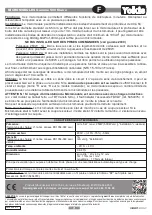
I.L. 40-386.3
(10/94)
2-17
NOTE:
For open breaker condition, the echo keying will not work due to lack
of the “SEND” signal from the remote terminal for an end Zone fault.
The remote terminal relies on Zone2 to clear the fault.
c. Programmable Reclosing Initiation
(Figure 2-19)
Same as for POTT scheme.
d. Carrier Receiving Logic
(Figure 2-22)
Same as for POTT scheme.
e. Channel Indicators
(Figure 2-22)
Same as for POTT scheme.
2.5.1.3
Directional Comparison Blocking
The basic operating concept of a Directional Comparison Blocking system
(Blocking)
are:
1)
Pilot relays
(Pilot Ø/PLTG)
are set to overreach; the Zone3 relays Zone3Ø/Zone3
G must be set in the reverse direction to detect the reverse external faults and
for carrier start.
2)
Pilot channel is an “ON-OFF” type power line carrier. Transmitter frequency at
each terminal can be the same. Channel is normally OFF until the carrier start
relay senses the fault and starts the transmitter.
3)
Pilot trip is performed when the pilot relay(s) operate(s) and a carrier blocking
signal is not received.
The
(Blocking)
system, as shown in
Figure 2-24
, includes the following logic (functional
display “
SystType
” should be set at the Blocking position):
a. Tripping Logic (
Figure 2-24)
1)
For a forward internal fault, the local pilot relay
(Pilot Ø
and/or
PLTG)
sees the
fault; output signal of OR-40 disables and stops the carrier start circuit (the
∆
I
and
∆
V starts the carrier before the distance unit picks up), via OR-16, S.Q. Tim-
er (0/150 ms) and AND-50, to prevent the local transmitter from starting. (The
receiver receives the signal from both local and remote transmitters.) At the
same time, output of OR-40 will satisfy one input of AND-48 and also starts the
channel coordination timer
(BLKT)
, range 0 to 98, in 2 ms steps. (See section
5.5.8d for BLKT setting.) After the preset time of the channel coordination timer,
logic AND-47 will satisfy AND-48, if there is no received carrier signal from either
remote or local on internal faults, and if the local transient block circuit
(TBM)
does not setup. Then AND-48 output will satisfy AND-52 and will produce pilot
trip. Pilot trip target would be the same as for POTT.
2)
For a forward external fault, the local pilot relay
(Pilot Ø
and/or
PLTG)
sees the
fault, and operates in the same manner as for the forward internal faults. How-
ever, at the remote terminal, the carriers units
∆
I/
∆
V/ Zone3 Ø(R)/Z3G(R)/
RDOG also sees this external fault and turns-on the transmitter via OR-41,
Summary of Contents for REL 301
Page 1: ......
Page 8: ......
Page 17: ...I L 40 386 3 1 10 10 94 2682F39 Sheet 1 of 2 Sub 2 Figure 1 2 REL 301 302 Layout Vertical...
Page 18: ...I L 40 386 3 10 94 1 11 2682F39 Sheet 2 of 2 Sub 2 Figure 1 3 REL 301 302 Layout Horizontal...
Page 19: ......
Page 20: ......
Page 44: ......
Page 46: ......
Page 48: ......
Page 49: ......
Page 51: ......
Page 53: ......
Page 54: ......
Page 55: ......
Page 56: ......
Page 57: ......
Page 60: ......
Page 62: ...I L 40 386 3 10 94 2 41 Figure 2 32 CO 2 Curve Characteristics 619596 Sub 2...
Page 63: ...I L 40 386 3 2 42 10 94 Figure 2 33 CO 5 Curve Characteristic 619597 Sub 2...
Page 64: ...I L 40 386 3 10 94 2 43 Figure 2 34 CO 6 Curve Characteristic 619598 Sub 2...
Page 65: ...I L 40 386 3 2 44 10 94 Figure 2 35 CO 7 Curve Characteristic 619599 Sub 2...
Page 66: ...I L 40 386 3 10 94 2 45 Figure 2 36 CO 8 Curve Characteristic 619600 Sub 2...
Page 67: ...I L 40 386 3 2 46 10 94 Figure 2 37 CO 9 Curve Characteristic 619601 Sub 2...
Page 68: ...I L 40 386 3 10 94 2 47 Figure 2 38 CO 11 Curve Characteristic 619602 Sub 2...
















































